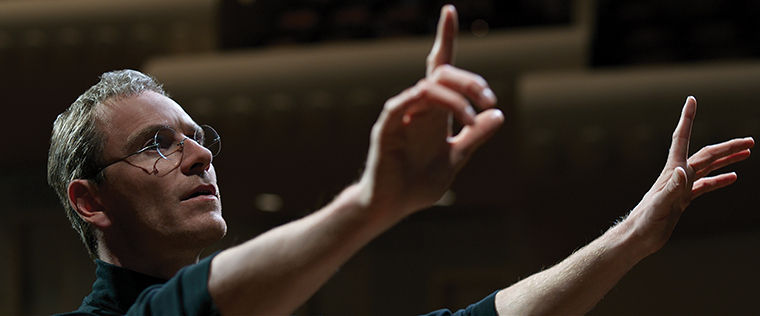‘Steve Jobs’ finds humanity in the abstract
In this image released by Universal Pictures, Michael Fassbender appears as Steve Jobs in a scene from the film, “Steve Jobs.” (Universal Pictures via AP)
November 2, 2015
Released Oct. 23, the Danny Boyle-directed “Steve Jobs” unfolds through a series of vignettes depicting the dramatic backstage occurrences of three iconic product launches—the Macintosh 128K in 1984, the NeXT Computer in 1988 and the iMac in 1998.
Like a well-structured symphony, these episodes function as variations on a central theme—in this case, the maniacal pursuit of excellence. After all, notorious egomaniac Steve Jobs, portrayed by Michael Fassbender, conducts the orchestra. And like the tyrannical inventor’s sleek machinery, each segment is designed with impeccable consistency.
The distinctive visual qualities of each segment simultaneously characterize the era of computing they take place within and Jobs’ shifting state of mind. There is a tremendous amount of fun to be found in watching the film progress from grainy 16mm film to sprawling 35mm and finally, to sleek high-definition digital video.
When Jobs unveils the NeXT in the film’s second act, his oldest friend, Apple co-founder Steve Wozniak, played by Seth Rogen, is shocked to learn all of the money has been spent on the machine’s design, despite its lack of an operating system.
But unlike the NeXT, the film is more than an empty spectacle. Written by “The Social Network’s” Aaron Sorkin, the rapid-fire dialogue manages to be emotionally revealing while deftly handling the exposition on the history of computing—no easy task.
The parallels between the struggle to build Macintosh computers and Jobs’ deeply flawed psychology abound. Most notably, he chooses to design his machines as closed systems—inaccessible to user modification; Even the back panels are designed to be unopenable without special tools. Like God made Adam and Eve, Jobs has made the Macintosh in his own image. All of this seems to stem from his deep-seeded abandonment issues, lack of a strong father figure and obsessive desire for total control.
On the topic of fatherhood, it would be impossible not to mention Jobs’ rejection of his own daughter, Lisa. Audiences cannot help but ask if his unwillingness to let her into his life is rooted in a rejection of his own humanity, which he has been forced to forego in his ruthless pursuit of success.
It is ironic that Macintosh brands itself as computing for the individual who values free thinking, but the Jobs depicted in the film only attains his vision through borderline-fascist leadership. Furthering this irony is the now-famous Macintosh advertisement aired during the 1984 Superbowl, in which a hammer is thrust at a screen displaying Big Brother’s face.
The suggestion is promoting the agenda of free thought and creativity on the scale Jobs desired was only possible if he himself was dictatorial, brooking no dissent. What if we all subscribed to Jobs’ Nietzschean philosophy that individuals create the times they live in rather than the other way around? These are deeply political questions, that bristle beneath the surface of the narrative.
Surprisingly, the film ends on a reassuring note. At each product launch, there are incessant reminders that Jobs will not allow himself to be late. Down to the second, he has to be onstage when the exhibition is scheduled to begin. However, before the unveiling of the iMac, he allows himself to be made tardy in favor of a tender moment with his estranged daughter, with whom he truly desires to mend his relationship. Before finally heading to the stage, he informs her he plans to “put songs in her pocket.”
Only after the launch of the iMac did Apple achieve the global success Jobs had been seeking for so long. Before attaining true success, he had to relinquish some control and allow himself to be more human.
During the first product launch of the film, Lisa—still a little girl—joins Jobs backstage and uses an early version of MacPaint to produce a rudimentary series of scribbles and geometric patterns. In oddly prescient fashion, she proclaims, “It’s an abstract.” Jobs is strangely touched. Like Lisa’s painting, Jobs comes off as little more than a collection of angular lines and jagged shapes, yet he is not without humanity. His humanity is abstracted, and he gives it to the world in the form of a personal computer.
Those looking for a film crackling with wit, color and a well-concealed heart will not be disappointed by “Steve Jobs.”








